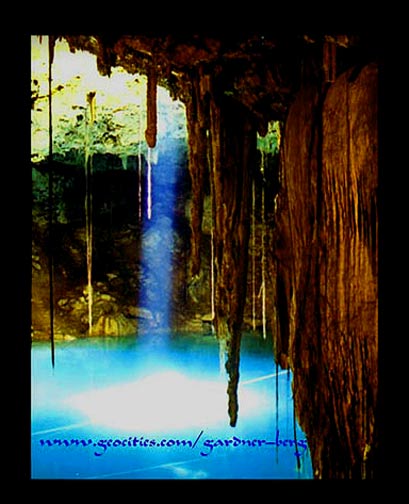
Cenote X-Keken, MEXICO
| Translate: EspaŮol - FranÁais - Deutsch - Italiano - PortuguÍs - Japanese - Korean - Chinese |

Cenote X-Keken, MEXICO
| Translate: EspaŮol - FranÁais - Deutsch - Italiano - PortuguÍs - Japanese - Korean - Chinese |

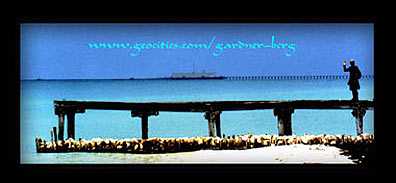
June 15, 1999 -- Another Combi heading north at 10am to the coastal town of Progreso (half hour) then we head onwards east (5km) to a small village called Chicxulub - a small, quiet and peaceful resort with a narrow beach filled with small boats and seaweed. If you look out to sea, you could see on the left the longest stone bridge pier in the world extending out from the town of Progreso.
Directly further out to sea from where we stood, there is a crater 200km in diameter, deep beneath the calm waters. Scientists have layed claim that this may be the site where a meteorite struck the earth 65 million years ago causing the extinction of the dinosaurs. Numerous diving expeditions have come up with geological evidence to support this.
 June 18, 1999 -- (1000) We leave Merida for a 2 and a half hour eastbound bus ride to the friendly town of Valladolid. There was a time during the 'War of the Castes' period (mid 19th century) when Indigenous people were prohibited from entering the town's plaza or to walk its streets.
June 18, 1999 -- (1000) We leave Merida for a 2 and a half hour eastbound bus ride to the friendly town of Valladolid. There was a time during the 'War of the Castes' period (mid 19th century) when Indigenous people were prohibited from entering the town's plaza or to walk its streets.
Now, Valladolid is a very pleasant place to stay, in close vicinity to the ruins of Chichen Itza.
June 19, 1999 -- (0830) We head north to Tizimin to connect with another bus heading further north to Rio Lagartos. This lagoon area was once used by the Maya to extract salt. Now, it's an official nature reserve to protect the habitats of local and migratory birds and turtle nesting beaches.
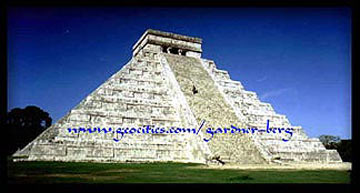 June 20, 1999 -- (0700) A 45 minute bus ride west to the ruins of Chichen Itza - built in the Late Classic period (600 to 900AD) by the Maya. This city became an important capital between 10th and 12th centuries AD. The art and architecture reflect both Maya and foreign elements. Recent work suggests that this style is of local Maya development, affected by increased traffic of Mexicans of the Late Classic and Early Post-Classic eras. The 'Cenote Sagado' or 'Well of Sacrifice' is a large natural well where offerings to the rain god
were dropped in - including pottery, incense, jewelery, human beings and animals. Central to this site is 'El Castillo' the large pyramid dedicated to 'Quetzalcoatl' - the 'Plumed Serpent', a characteristic of Toltec culture.
June 20, 1999 -- (0700) A 45 minute bus ride west to the ruins of Chichen Itza - built in the Late Classic period (600 to 900AD) by the Maya. This city became an important capital between 10th and 12th centuries AD. The art and architecture reflect both Maya and foreign elements. Recent work suggests that this style is of local Maya development, affected by increased traffic of Mexicans of the Late Classic and Early Post-Classic eras. The 'Cenote Sagado' or 'Well of Sacrifice' is a large natural well where offerings to the rain god
were dropped in - including pottery, incense, jewelery, human beings and animals. Central to this site is 'El Castillo' the large pyramid dedicated to 'Quetzalcoatl' - the 'Plumed Serpent', a characteristic of Toltec culture.
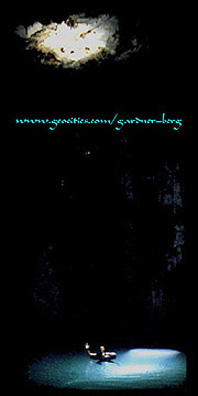 As previously mentioned on April 8 entries,Quetzalcoatl had been expelled from Tula by a rival faction (according to legend, the Toltec priests). On each face of this pyramid, as well as on the main facade, the ramps were designed to resemble the bodies of snakes, with their heads resting at the foot of the slope. The main entrance to the temple has 3 openings , each formed by 2 serpent-shaped columns. An impressive structure.
As previously mentioned on April 8 entries,Quetzalcoatl had been expelled from Tula by a rival faction (according to legend, the Toltec priests). On each face of this pyramid, as well as on the main facade, the ramps were designed to resemble the bodies of snakes, with their heads resting at the foot of the slope. The main entrance to the temple has 3 openings , each formed by 2 serpent-shaped columns. An impressive structure.
June 21, 1999 -- 7kms away from Valladolid is Dzitnup where the 'Cenote of Xkeken' is situated. It is a large limestone cavern with a deep natural water hold for swimming. The waters are very clear and blue with stalactites overhead provide for a very relaxing dip. But the walk back to town in the seemingly endless heat had us yearning for a similar swimming hole in town.
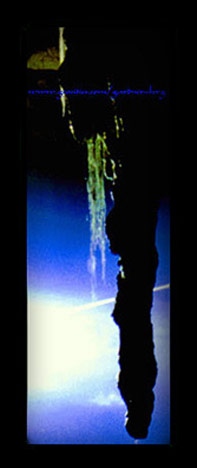 June 22, 1999 -- A very early start to visit the ruins of Coba (4:30am, 2 and half hours roughly SE of Valladolid). The site is located among shallow lakes and surrounded by very dense jungle and has a well-preserved system of raised stone causeways/roads, which connect suburban and downtown areas or led to distant cities. The ancient sacbes pass through this city. The architecture is mostly unrestored but the area they cover was vast (approx. 70sq.km.). One could only imagine this place durng its heyday (8th to 9th century with an estimated population between 40 000 and 50 000).
June 22, 1999 -- A very early start to visit the ruins of Coba (4:30am, 2 and half hours roughly SE of Valladolid). The site is located among shallow lakes and surrounded by very dense jungle and has a well-preserved system of raised stone causeways/roads, which connect suburban and downtown areas or led to distant cities. The ancient sacbes pass through this city. The architecture is mostly unrestored but the area they cover was vast (approx. 70sq.km.). One could only imagine this place durng its heyday (8th to 9th century with an estimated population between 40 000 and 50 000).
June 23, 1999 -- (0745) 3 hours by bus to our next destination: Playa del Carmen (usually called just 'Playa'), about an hour down the eastern coast from Cancun, for sun, sand, and again, no surf.
This area is certainly Mexico's most 'touristy'. Playa is a popular place for scuba diving and snorkeling - particularly at the nearby island of Cozumel. This island was a 'Post-Classic' centre for the canoe trade of Mesoamerica and also a pilgrimage site for the worship of the moon goddess, Ixchel - she is also goddess of pregnancy, childbirth, all things feminine, floods, tides and destructive waters.
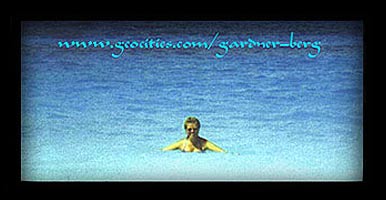 We spend about a week here making the odd day trip or two north to Cancun and south to the coastal ruins of Tulum.
We spend about a week here making the odd day trip or two north to Cancun and south to the coastal ruins of Tulum.
June 29, 1999 -- We take a bus to the village of Tulum (1 hour), then walk 5km to the site. The ruins of the walled Tulum has many well-preserved masonry, stucco buildings and murals of the late Post-Classic period. The place was packed with tourists making it rather difficult to study the structures more closely - we were always in the way of the tour guides - some of whom are quite ill-informed; it's always a shame to hear things like "...only virgins were sacrificed..." being fed to a generally receptive group of tourists.
 June 30, 1999 -- We head south along the coast to the city of Chetumal - situated close to the Belizean border. Not a particularly picturesque place but good enough to serve us as a base to visit 4 ruin sites directly inland.
June 30, 1999 -- We head south along the coast to the city of Chetumal - situated close to the Belizean border. Not a particularly picturesque place but good enough to serve us as a base to visit 4 ruin sites directly inland.
July 2, 1999 -- We catch a bus going to Francisco Villa and get dropped off at the junction to Kohunlich on the way. From there we walk 9km to the ruin site SW has on its side giant masks - said to images of the sun god and other divine beings, all symbols of legitimate power. The site itself is completely enveloped by dense palm forest.
It was a particularly cloudy day but the heat and humidity was unrelenting and we were not really looking forward to the long walk back to the main road. As luck would have it, some site workers were heading home in our direction and were kind enough to take us on the back of their pick-up truck back to the junction, where buses to Chetumal can be flagged down -saving us a 2 hour walk.
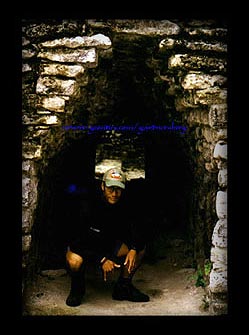 July 4, 1999 -- (0900) A bus to the small village of Xpujil for 2 days to view ruins there along with 2 others nearby - Chicanna and Becan.
July 4, 1999 -- (0900) A bus to the small village of Xpujil for 2 days to view ruins there along with 2 others nearby - Chicanna and Becan.
Xpujil recently restored, has a large pyramid built in 8th century AD. A 12 km walk westward is Chicanna - a site with great designs around a temple doorway resembling the open-fanged jaws of the plumed serpent. There were also stylised Chac masks on a pyramid nearby. 2 km away from here is Becan with its waterless moat and remains of a wall, indicating a region of violent conflict.
Just down the road towards Chicanna is the isolated 'Ramada Chicanna Eco Village' - opened in 1995. There is supposedly 100 thatched cabins, restaurant, bar, pool, jacuzzi, solar heating, rainwater showers etc... around US$90 a night. We're not so sure about the concept of Eco-villages - certainly not 'ecologically-friendly' to one's bank account. If concepts for saving the environment is of global importance, why put a price tag on it?
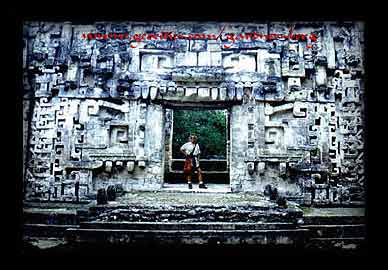 Again, water consumption was very high during the walk back to Xpujil village (9kms). The village doesn't receive many foreigners hence services are few and
a little expensive; a little rundown as well - a wildwest feel. Xpujil village seems more of a transit stop for heavy vehicles to refuel. The foreign travellers we have seen were in 4WD vehicles most probably making their way to the more remote Mayan sites like Hormiguero, Rio Bec or even Calakmul - places that are, at present, inaccessible by public transport - our preferred means of getting around throughout.
Again, water consumption was very high during the walk back to Xpujil village (9kms). The village doesn't receive many foreigners hence services are few and
a little expensive; a little rundown as well - a wildwest feel. Xpujil village seems more of a transit stop for heavy vehicles to refuel. The foreign travellers we have seen were in 4WD vehicles most probably making their way to the more remote Mayan sites like Hormiguero, Rio Bec or even Calakmul - places that are, at present, inaccessible by public transport - our preferred means of getting around throughout.
Our return to Chetumal marks the end of our 4 month journey in Mexico and the beginning of our travels in Central America.
Photos and Text Copyright © 1999-2001 Gardner-Berg. All rights reserved.
Sources of Further Reading-
Baudez, Claude and Picasso, Sydney. "The Lost Cities of the Maya" Henry N Adams, Inc., New York, NY. 1992.
Coe, Michael D. "Breaking the Mayan Code".
Morley, Sylvanus. "An Introduction to the Study of Mayan Hieroglyphs" 1975
Schele, Linda and Freidel, David A. "A Forest of Kings: The Untold Story of the Maya" Morrow New York, NY.
Stephens, John L and Catherwood, Frederick. "Incidents of Travel in Central America, Chiapas and the Yucatan"
Stuart, George C and Stuart, Gene S. "The Mysterious Maya" National Geographic Society, Washington DC., 1997.
Tedlock, Dennis. "Popol Vuh: The Mayan Book of the Dawn of Life" 1996
Wright, Ronald. "Time Among the Maya"

